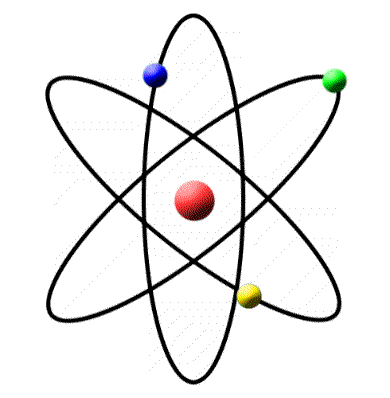The radius of innermost orbit of a hydrogen atom is 5.3x10-11 m. What is the radius of the third allowed orbit of the hydrogen atom?
The radius of innermost orbit of a hydrogen atom is 5.3x10-11 m. What is the radius of the third allowed orbit of the hydrogen atom?
1.06Å
1.59Å
4.77Å
0.53Å
The Correct Option is C
Solution and Explanation
To determine the radius of the third allowed orbit of a hydrogen atom, we utilize the formula for the radius of the nth orbit in the Bohr model:
rn = n2 × r1
where:
- rn is the radius of the nth orbit.
- n is the principal quantum number.
- r1 is the radius of the innermost orbit (ground state), given as 5.3×10-11 m.
For the third orbit (n = 3):
r3 = 32 × 5.3×10-11 m = 9 × 5.3×10-11 m = 47.7×10-11 m
To convert this into angstroms (1 Å = 10-10 m):
r3 = 47.7×10-11 m / 10-10 = 4.77 Å
Thus, the radius of the third allowed orbit is 4.77 Å.
Top Questions on Atoms
- Prove that, in the Bohr model of the hydrogen atom, the time period of revolution of an electron in the \( n \)-th orbit is proportional to \( n^3 \).
- The distance of closest approach of an alpha particle from a nucleus when the alpha particle moves towards a nucleus with a kinetic energy 'E' is 'x'. The distance of closest approach when the alpha particle approaches the same nucleus with kinetic energy 0.4E is
- The ratio of frequencies of second line of Lyman series and third line of Balmer series of hydrogen atom is:
- The ratio of wavelengths of second line in Balmer series and the first line in Lyman series of hydrogen atom is
- Describe the atomic model of Rutherford. How did Bohr model removed its drawbacks?
Questions Asked in NEET exam
- A microscope has an objective of focal length \(f_o = 2\) cm and an eyepiece of focal length \(f_e = 4\) cm. The tube length of the microscope is \(L = 40\) cm. If the distance of distinct vision of eye is \(D = 25\) cm, the magnification in the microscope is:
- NEET (UG) - 2025
- Optical Instruments
- Which one of the following is an example of ex-situ conservation?
- NEET (UG) - 2025
- Ex-Situ Conservation
- Which one of the following compounds can exist as cis-trans isomers?
- NEET (UG) - 2025
- Organic Chemistry
- Who proposed that the genetic code for amino acids should be made up of three nucleotides?
- NEET (UG) - 2025
- Molecular Biology
- An electron (mass \(9 \times 10^{-31}\) kg and charge \(1.6 \times 10^{-19}\) C) moving with speed \(c/100\) (\(c\) = speed of light) is injected into a magnetic field of magnitude \(9 \times 10^{-4}\) T perpendicular to its direction of motion. We wish to apply a uniform electric field \( \vec{E} \) together with the magnetic field so that the electron does not deflect from its path. (speed of light \(c = 3 \times 10^8\) m/s):
- NEET (UG) - 2025
- Electric Field
Concepts Used:
Atoms
- The smallest unit of matter indivisible by chemical means is known as an atom.
- The fundamental building block of a chemical element.
- The smallest possible unit of an element that still has all the chemical properties of that element.
- An atom is consisting of a nucleus surrounded by one or more shells of electrons.
- Word origin: from the Greek word atomos, which means uncuttable, something that cannot be divided further.
All matter we encounter in everyday life consists of smallest units called atoms – the air we breath consists of a wildly careening crowd of little groups of atoms, my computer’s keyboard of a tangle of atom chains, the metal surface it rests on is a crystal lattice of atoms. All the variety of matter consists of less than hundred species of atoms (in other words: less than a hundred different chemical elements).

Every atom consists of an nucleus surrounded by a cloud of electrons. Nearly all of the atom’s mass is concentrated in its nucleus, while the structure of the electron cloud determines how the atom can bind to other atoms (in other words: its chemical properties). Every chemical element can be defined via a characteristic number of protons in its nucleus. Atoms that have lost some of their usual number of electrons are called ions. Atoms are extremely small (typical diameters are in the region of tenths of a billionth of a metre = 10-10 metres), and to describe their properties and behaviour, one has to resort to quantum theory.